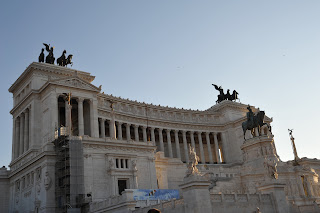On Piazza Venezia, you will find one of the most famous - and controversial - monuments of the whole Eternal City: The "Vittoriano", or "Altare della Patria" - "Altar of the Fatherland" - A monument built between 1911 and completed only in 1925 to celebrate the 50th Anniversary of the Unity of the Country (1861-1911), and to commemorate Vittorio Emanuele II, the first King of united Italy (statue in the middle of the monument.)
The discussions subsided after the end of World War I, with the enthusiasm following the Victory of 1918. In 1921 at the same monument was buried the Unknown Soldier, a soldier chosen on a battlefield in north-eastern Italy among those who had no identification plate with them, transported to Rome with great honours, and buried there with great solemnity to symbolize the sacrifice of all the soldiers during all wars, but especially in WW I which for Italy was considered as the last one of the Wars for Independence, having manage to reconquer from the Austian Empire the territories of Trento and Trieste in northern Italy.
During the following Fascist period, with the ideal of Fatherland becoming of paramount importance for the regime's propaganda, the Vittoriano became the stage for so many ceremonies of all kinds, with the military ones being the most frequently represented on the site.
After the war, the monument lost part of its importance, and started becoming the target for heavy criticsm by the people: the allegedly not graceful shape of the monument, its being all white, and the face that it doesn't blend too well with the more ancient surroundings, earned the monuments nicknames such as "The Typewriter" (due to its shape) or "The Wedding Cake" due to the color.
In more recent times, after having suffered a bomb attack back in the late 60s, the monument has been closed to the public only to be reopened in 1997. In 2011 it went back to his splendour and importance thanks a thorough refurbishment and for becoming one of the focal points of the celebrations for the 150th Anniversary of the Unity of Italy.
So, it's up to each one of us to decide if the Vittoriano is just a Typewriter, a Wedding Cake, or the materialization of our National Pride.












